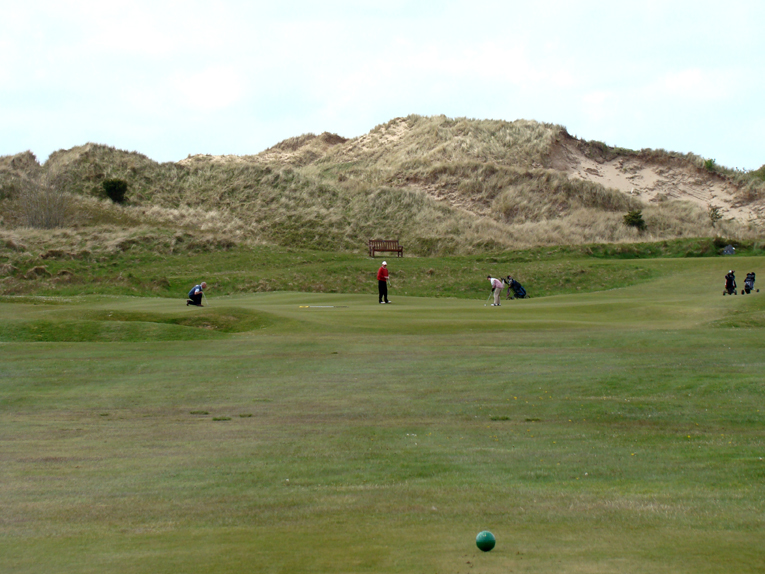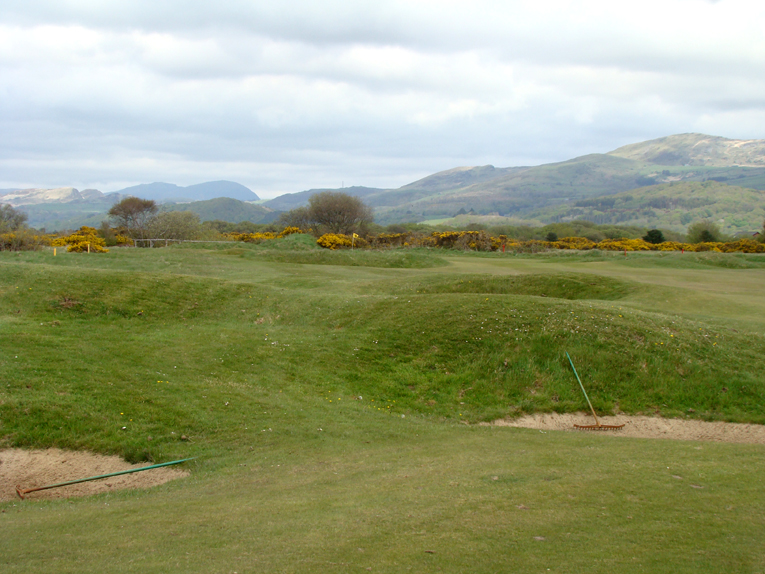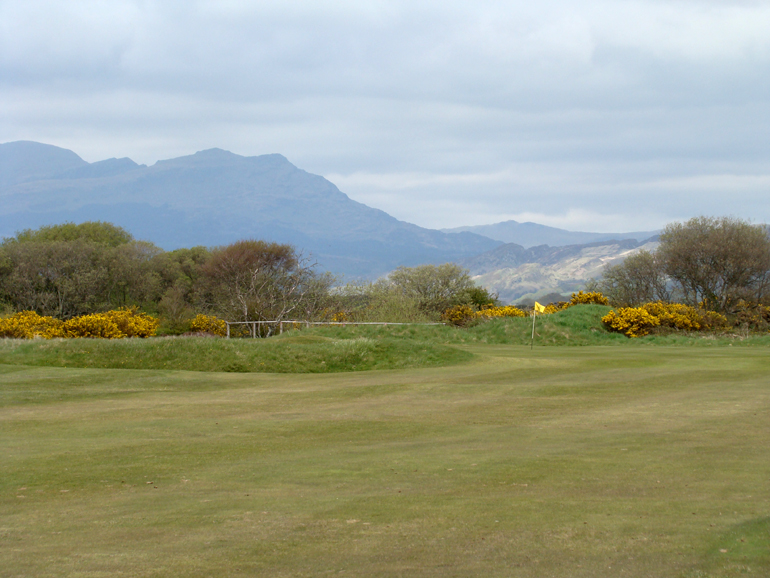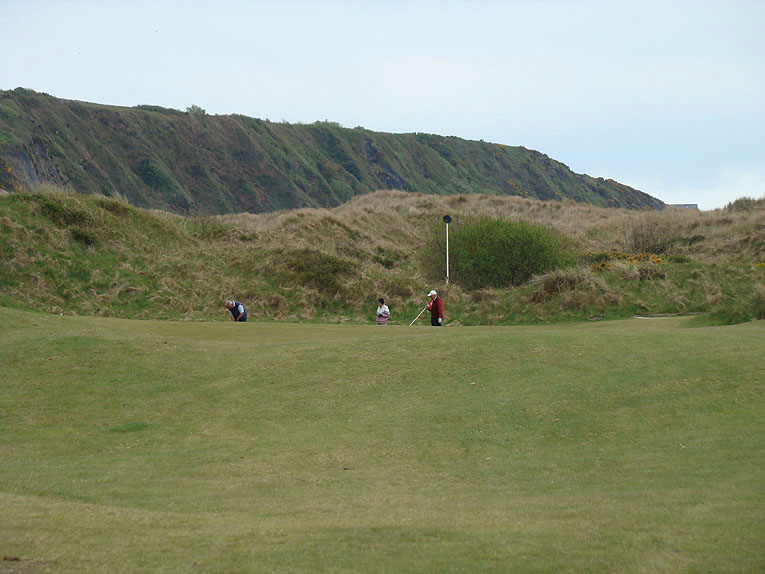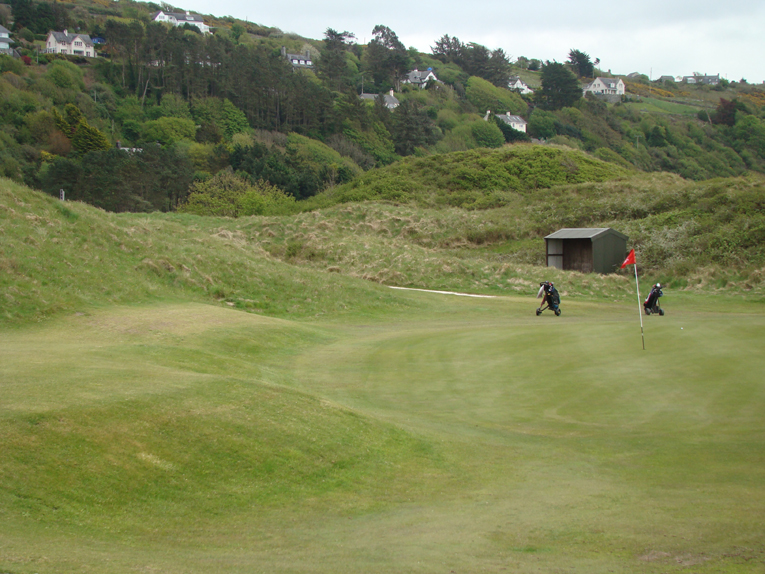Royal St. David’s Golf Club
Gwynedd, Wales, United Kingdom
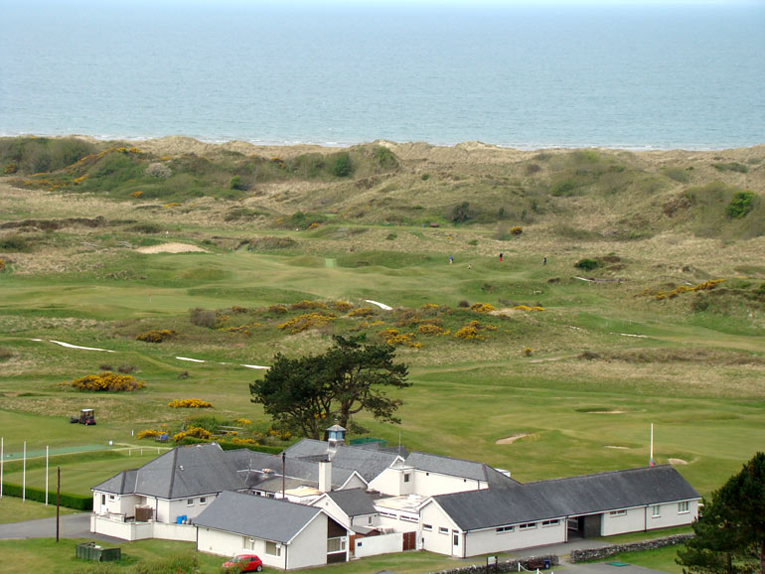
As seen from Harlech Castle, Royal St. David’s clubhouse is in the foreground followed by its scintillating closing stretch of holes in the dunes. The golfer in red battles down the roly-poly fourteenth.
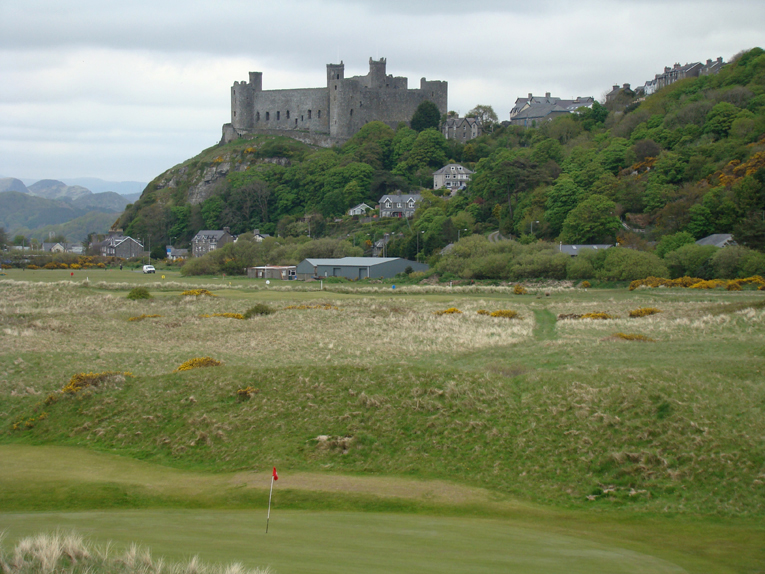
As seen from the course, the medieval fort’s presence is felt on the golf and reminds one of battles from centuries long past.
The itinerant golfer who makes Harlech his destination will discover that while Wales is just a short jaunt from the major termini of Britain and Ireland it is an alien enchanted land. The road signage is in Welsh, an ancient language, quite alive if not vibrant that seems to lack the requisite vowels. The spoken word which pervades the local radio is both gutteral and melodious and full of sounds unfamiliar to the English speaker. The charms of Royal St. David’s become apparent about an hour from the first tee. Whether arriving from the south, east or north, the ride to reach Harlech and the Llyn peninsula is through some of the world’s magical countryside. With a close proximity to the Manchester/Liverpool area, many arrive from the northeast which necessitates a drive through Snowdonia National Park. The sheep studded glyns ablaze with gorse and heather fall sharply to flowing rivers. The golfer can easily be forgiven for thinking that he has somehow landed in J.R. Tolkein’s Middle Earth!
There is little wonder why Harold Finch-Hatton and several English aristocrats determined to build a golf course in this part of the world. To the west lay great dunes, to the north Snowdon Mountain, the tallest peak in both Wales and England and to the east the thirteenth century Harlech Castle built by Edward I – diverse beauty in all directions. Golf would make a most fitting addition.
The course that Finch-Hatton laid out with the help of William Henry More in 1894 serves as the bones for the course that is played today. Golfers like John Ball and Harold Hilton from Hoylake quickly put their stamp of approval on the layout. Finch-Hatton’s enthusiasm was justified and Wales had the makings of its first great course. When Finch-Hatton passed in 1904, W.H. More became the course custodian and served as Secretary for several decades. Richard Fisher notes in his A Centenary History of the Royal St. David’s Golf Club that Arthur Croome called More the eighth wonder of the world. Fisher credits More as much as any single person for the evolution of the course and club and it was More’s calm discreet demeanor that set the standard of conduct that prevails to this day.
Over the past nearly 120 (!) years, bunkers have come and gone but only the third hole occupies a totally different playing corridor to the one that Finch-Hatton and More laid out. For a course constructed in the hickory era, the playing corridors are markedly expansive and there is plenty of room between holes.
A quick glance at the scorecard might mislead as it shows the championship markers to measure only 6,650 yards. ‘Holiday golf’ might come to mind, a term the Brits use in a (nearly!) derisive manner to signify a course that doesn’t require proper hitting. Nothing could be further from the truth. At Harlech the golf is constantly demanding, requiring thoughtful, well executed shots. The scorecard yardage is deceiving because the course’s pair of par fives are offset by a quintet of 3 pars. In fact, the two fives are back-to-back and head in opposite directions. Given the windy locale, if one is reachable the other becomes a true three shotter. So there is only one par five to beat up, instinctively the good golfer senses challenge – and he would be right! Seven par fours measure between 430 and 470 yards and two of the par threes are over 200 yards. St. David’s composition reminds Brits of Rye and Americans of Wannamoisett – and everyone knows what tight, exacting pars both those courses represent.
The pleasure of the game is derived from the incomparable setting and the soft hands placed on the landscape by Finch-Hatton and those that followed. Harsh man-made features are mercifully absent. A modern architect might have moved more dirt on the front nine where the holes are farther from the dunes land and therefore flatter. Such action would have been at odds with the environment and the golf almost certainly not improved upon. Other modern architects might have built up the green pads to create more defined targets. Again, a potential mistake, the greens at Harlech seem to rise organically out of the fairway. Their interior contours are muted relative to those of modern times but remain full of interest and subtlety. Be it the depression in the first green, the puff to the right on the eighth or the steep pitch to the ninth at the base of the dune, the golfer always finds himself fully engaged.
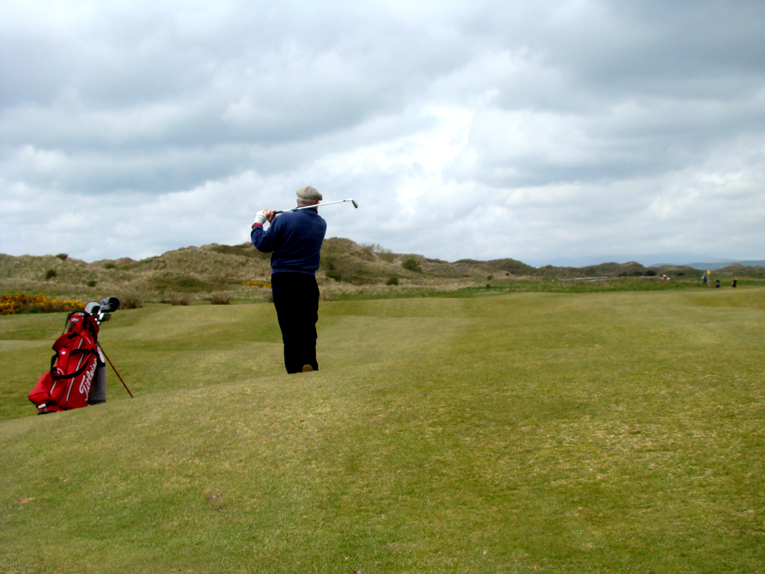
Don’t dare call the first eight holes flat! Look at the stance of this past Club Captain in the first fairway. The one to two foot random humps and bumps are nothing short of ideal for golf.
Most golfers will almost assuredly hit fewer greens in regulation than so accustomed. The reason is obvious: only two par 5s, five par 3s and a series of testing two shotters. The golfer faces an unusually high number of mid-iron to utility club approaches. Missed greens mount and the state of one’s short game comes under increased scrutiny. Since the greens are ample in size, the golfer typically has plenty of room and the player with tight control on his pitch and run shots has the advantage. No wonder then that Harlech has long been appreciated for its complete and all around golf challenge, a fact born out in that it has hosted many important events. All players are drawn to a course in such a location but good players especially have been quick to praise Harlech. Frank Pennick in his 1952 Home of Sport golf book captured it perfectly:
Like many great seaside links Harlech has its flat holes between sandhills and those where the dunes and hillocks hold more than just a lineman’s brief: but, as every course of renown, it is in every way natural golf. No two fairways run parallel to one another; tough rushes, bents, and dog roses provide the main obstacles on either side apart from the dunes themselves. There were more bunkers once, but many that were not essential were filled in, yet leaving those guarding the fine large greens, which are justly the pride of the club. It is a links where long driving greatly helps, for half the holes are upwards of 435 yards, so that without that asset a great deal of hard work is thrown upon the brassie and the spoon. This trail of strength begins at the very first hole.
After World War II, Guy Campbell was brought in to make modifications to the course. While Harlech had survived better than most links, an increasingly trafficked public walkway to the beach became problematic for holes 3, 4 and 12 necessitating change. The old third, of which Patrick Dickinson was so fond, bent around a stone wall and ended more or less where today’s fourth tee is found. It was full of interesting playing angles and options but with homes and walkers nearby, it was doomed for safety reasons. Campbell straightened the third, built the new fourth and benched the twelfth tee into the dunes. Essentially, the course that we know now was in place and Frank Pennick’s words of ‘natural golf’ ring as true today as they did over sixty years ago.
Holes to Note
Fourth hole, 185 yards; Like Deal and Machrihanish, Campbell’s restraint in working with the land is noteworthy. Look at the photograph below. The tee is glued to the ground and the green seamlessly rises from the fairway. The ripples in the green are consistent with the other putting surfaces around the course. This hole was a net improvement over the old fourth and helps make up for the loss of the original third.
Fifth hole, 395 yards; One of the great attributes of Harlech is how rarely two holes go in the same general direction. Five and six both head easterly but there are subtle nuances of fairway bend and bunkering that make the holes play differently. Importantly, the holes don’t scream at you, revealing all their secrets at once. Instead, the golfer must decipher the best attack angles over many rounds. As example, though not the shorter route home, the proper play at the fifth is right off the tee as the green opens up nicely from that side while the left side is favored at the sixth. An ace member player like Bridget Jackson has always enjoyed a marked ‘local’ advantage in competitions contested here.
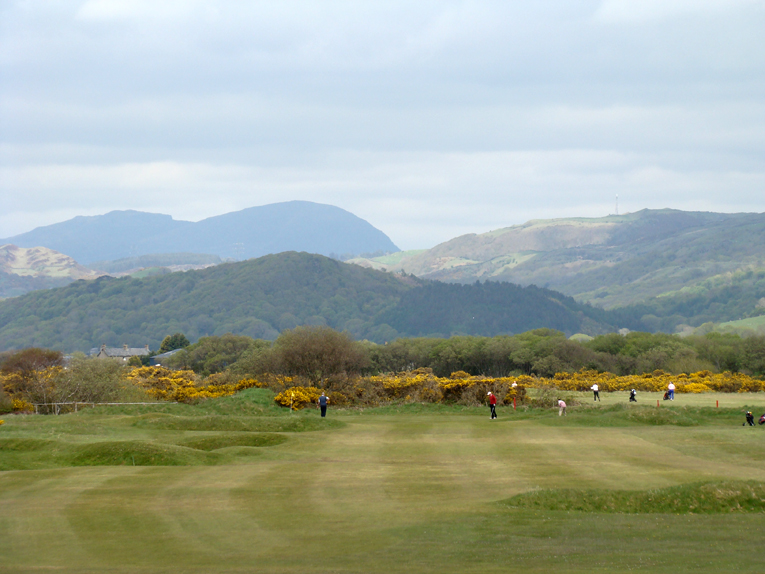
Some critics sniff at the fifth through eighth holes that play over an old morfa –Welsh for a sheep grazing plain. Really?! Are you kidding? Look at the environment in which you can enjoy the game.
Sixth hole, 400 yards; Just how much can the wind blow here? Head Professional Gareth Lewis recounts a round in May, 2013 when his foursome partner chipped back to the green because Gareth’s tee ball finished over it! His tee ball skirted just left of the long cross bunker fifty yards shy of the putting surface. Under more normal playing conditions, this cross bunker coupled with a slight dip before the putting surface regularly create depth perception problems for one’s approach.

The sandy soil enables the creation of deep bunkers even for holes on the morfa. This wayward tee ball into a bunker at the right edge of the fairway left the disgruntled golfer no option but to pitch out.
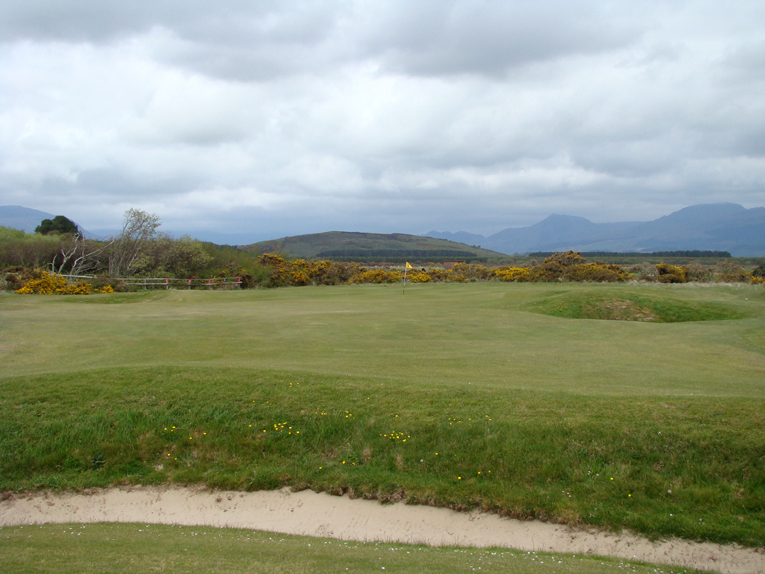
Cross hazards like this one play an important role. Only those that find the fairway off the tee are likely to clear them with their second shots. Similar hazards appear at the seventh, tenth, and seventeenth holes. Good driving is of paramount importance at Harlech.
Ninth hole, 180 yards; Harlech’s most famous stretch of holes is the fourteenth through seventeenth as they play in, among, and over the dunes in such an exhilarating manner to be the stuff of dreams. These holes are well known throughout the United Kingdom and beyond. Yet, what doesn’t seem to be as appreciated is how well situated the prior five holes (beginning here) are and how they play along and on the edge of the dunes. Similar to the fourth, Finch-Hatton laid out the hole so that the sixty foot dunes form a most impressive backdrop. Here the opening to the putting surface is in from the left. The green features the most back to front tilt of any on the course and short putts are missed here with greater frequency than anywhere on the course.
Tenth hole, 460 yards; It’s worth noting that the ninth green is the farthest point on the course from the clubhouse. Unshackled by the modern convention of returning nines, it comes as no surprise to find a very strong tenth hole. Indeed, it is the number one handicap hole on the course – and plays like it. Drainage ditches provide a key element here and at some of the other mighty par fours like the first and third. At the tenth the ideal drive is placed perilously close to the trench that hugs the left side before angling across the fairway 100 yards short of the green.
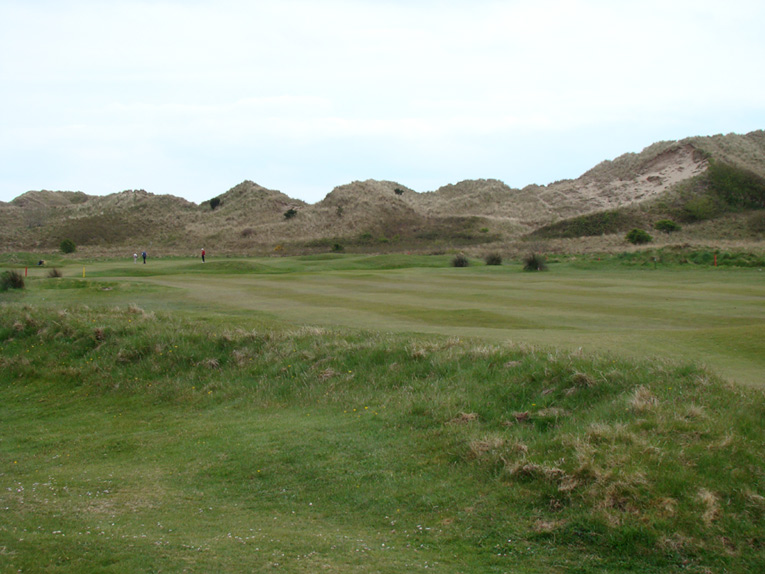
Note the lateral hazard stakes up ahead. The gloriously wide sandy Harlech beach is just over the dune from the tenth.
Eleventh hole, 150 yards; While the greens of the prior two par 3s were gracefully pushed up from their surrounds, this one was sunk down between dunes. Much of the putting surface is obscured by a pair of bunkers that front the green. Good and bad breaks help define links golf and this hole provides more good fortune than most on the course. Favorable kicks from the high dune walls sometimes rectify the error of pulled or pushed tee balls. This hole’s playing characteristics fit in nicely between the bruising tenth and twelfth holes.
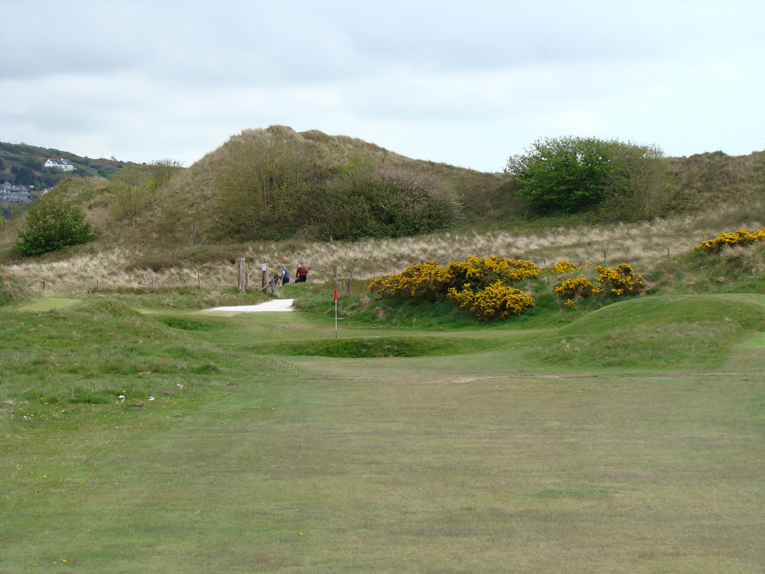
A real charmer, the green is snuggled low between dunes. Ideally, every links would have such a short hole where the ability to flight the ball through the wind is paramount.
Twelfth hole, 435 yards; À la the fifth and sixth, a bend in the fairways and bunkering schemes conspire to make the twelfth and thirteenth holes play differently even as they head in the same general direction over similar land. The view from Campbell’s elevated twelfth tee shows the green ahead with the straight line view from tee to green being well right of the fairway. This is what the great golf intellect Max Behr referred to as the ‘Line of Instinct.’ The golfer needs to take care in properly aligning his tee ball and not let the flag act as a siren, wooing him too far right. Six bunkers in the driving area thwart any hope of reaching the green in regulation should one’s tee ball come to rest in one. The Line of Instinct shifts to the left from the thirteenth tee so the golfer needs to stay alert and aim away from the flag off the tee even though he knows that makes the hole will play longer.
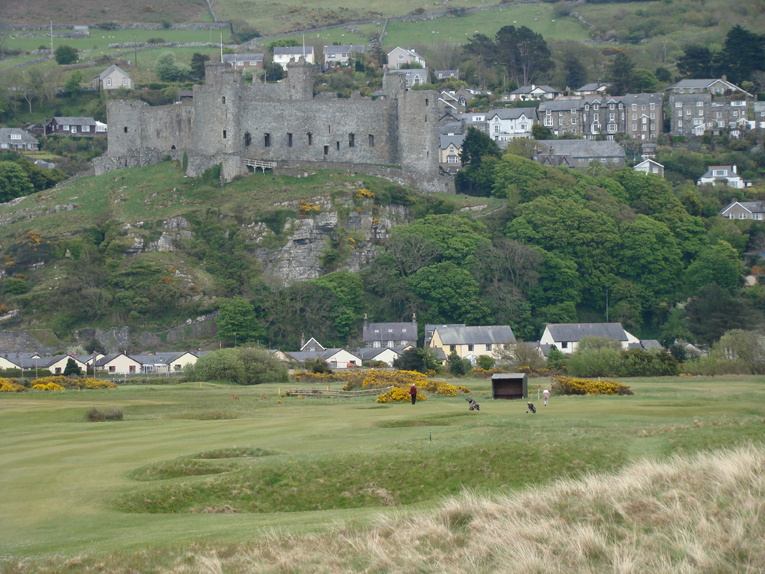
Campbell quite correctly moved the tee away from the beach path, benched it into the dune line, and lined play up to the one-of-a-kind backdrop of Harlech Castle. This gentle left to right bend in the fairway is balanced against the thirteenth’s which plays from right to left.

Old, established courses have a way of featuring unusual hazards. This imaginative bunker fifty yards short of the twelfth green is one such example at Harlech.
Fourteenth hole, 220 yards; In Finch-Hatton’s day, both the green and flag were blind from the tee and you hit over the deep and famous Castle bunker. As the game’s popularity increased, practical considerations took hold. At some point in the 1920s, the dune scape 90 yards off the tee was nudged down some seven feet so that golfers could discern when the green was clear. Happily, the putting surface remains obscured from view to this day.
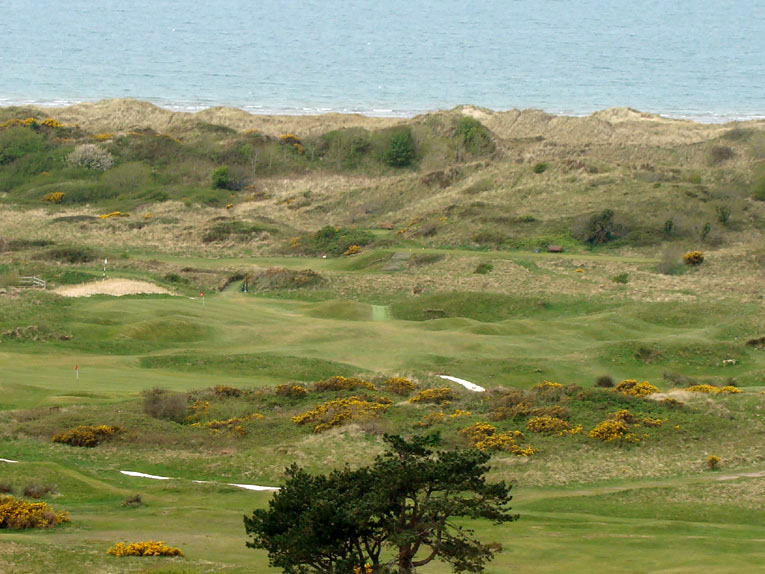
As seen from the castle, the fourteenth plays from right to left and calls for a long shot over broken ground to a green at the base of the reclaimed dune. No bunkers needed!
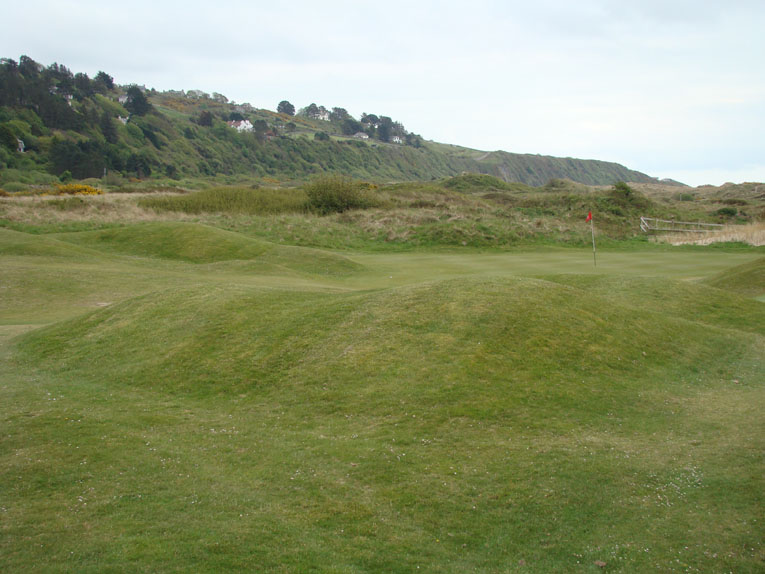
The array of recovery shots one faces during a playing season is to be lauded. The fourteenth is both long and hard as well as fun and memorable, a combination that links golf serves up more readily than heathland or parkland courses.
Fifteenth hole, 440 yards; The next three holes form a classic triangle, the exact sort of design feature that master architects like William Flynn strived for in windy locales like Shinnecock Hills. That amateur architect Finch-Hatton recognized the inherit benefits of such a configuration is impressive. So too is the supreme quality of all three holes. One thinks that even his brother, Denys, made famous in Out of Africa by Isak Dinesen would have approved of man’s subtle though intelligent interaction with the land.
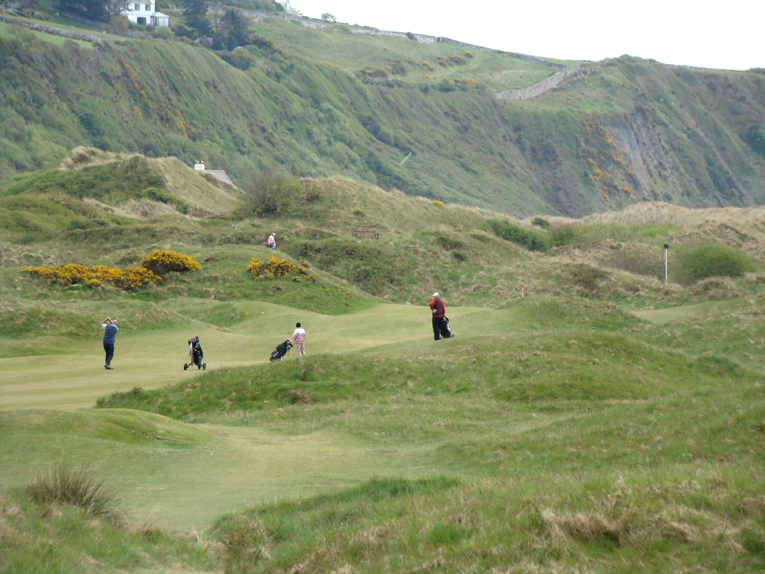
A hole with few peers – the bunkerless fifteenth at Harlech. The tee ball is played to an angled fairway and again in true links fashion…
Sixteenth hole, 350 yards; From this tee high on the dune the golfer is treated to a view of Tremadog Bay and the Llyn Peninsula. So stunning is the vista that the golfer can’t help but wonder why a few more holes aren’t back in these majestic dunes, so broad and pervasive are they. The answer is Mother Nature; the club has tried on the odd occasion to add holes but the dune line is growing by accretion and any fledging holes have been lost quickly to blowing and shifting sand. So be it! Time to turn one’s gaze from the west to the east and tackle the most heavily defended green on the course.
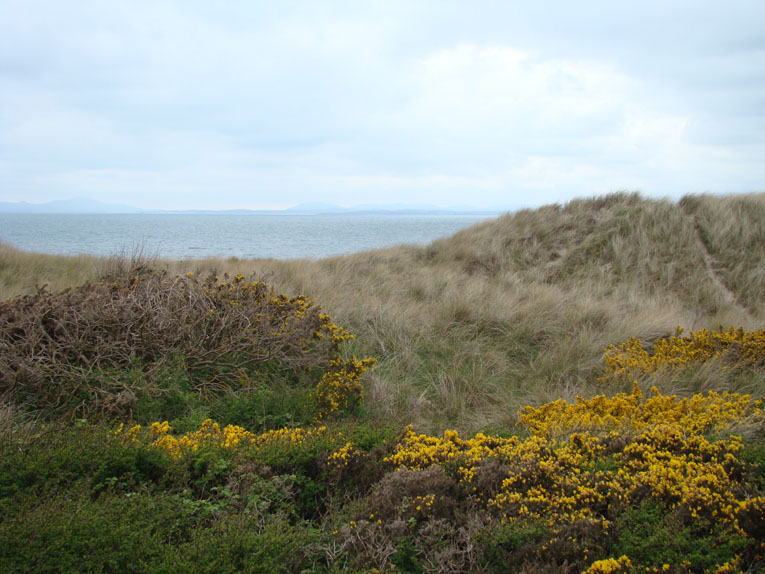
Standing high on the tee, the golfer is afforded a view west away from the course that highlights the bracing environment.
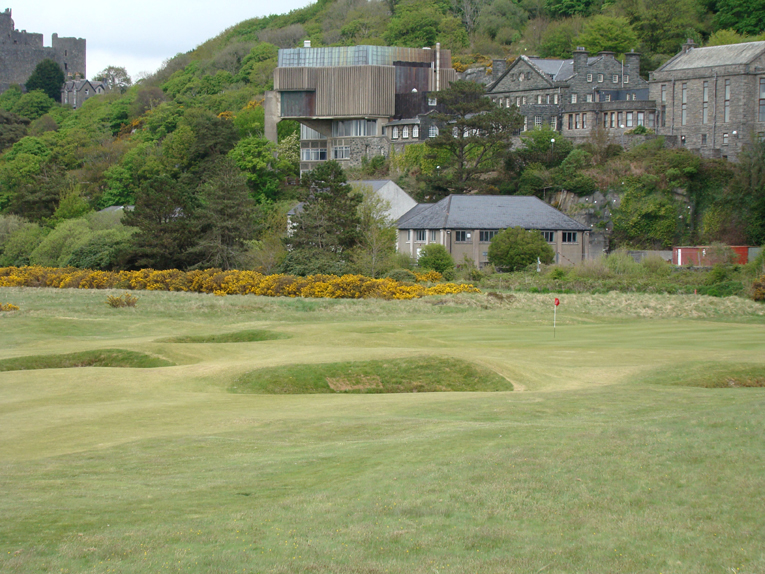
Ringed by the deepest bunkers on the course, the sixteenth demands precision as one might expect on a hole of such modest length.
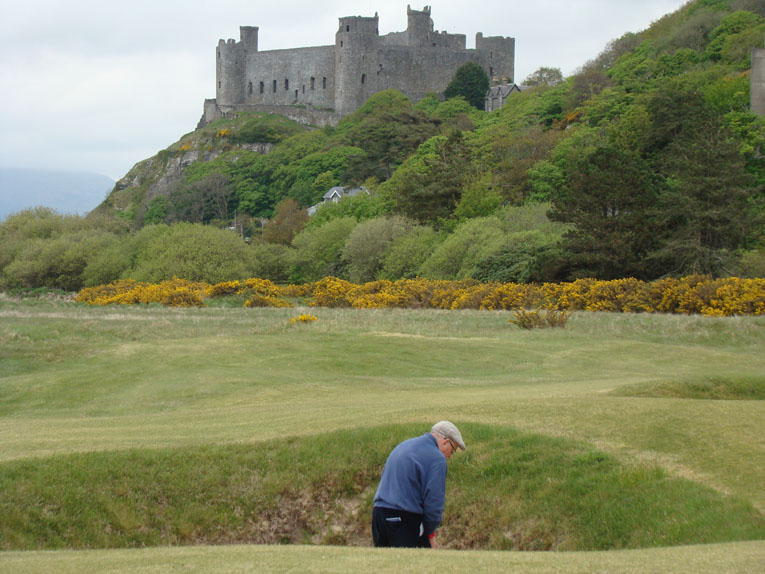
The golfer’s ball is too close to the front of the bunker. The sixteenth green is to his right … but he is forced to play out sideways.
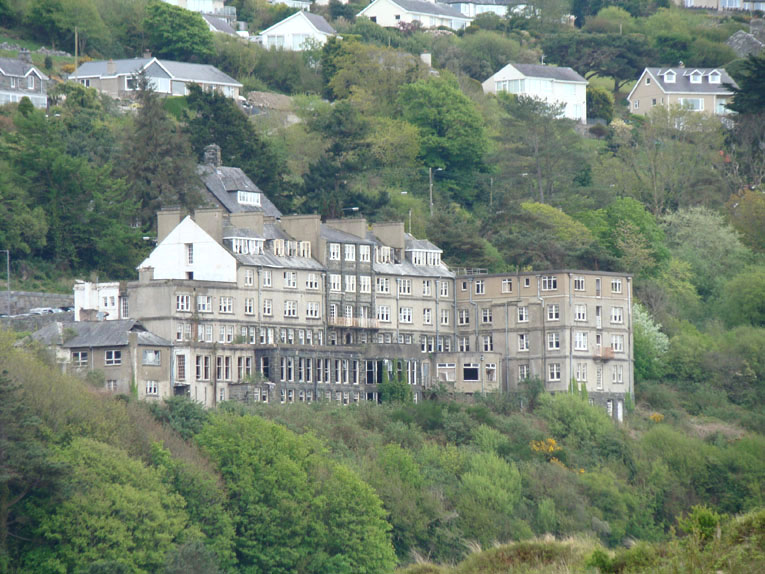
Built in 1910, the St. David’s Hotel lorded down on the course and sixteenth hole in particular for decades before closing near the start of the following century. One imagines the halcyon days when the orchestra played and the tuxedoed gents and gowned ladies peered down upon late day golf events. The heart breaks. Perhaps one day this grand Edwardian edifice will be restored? Or maybe a similar arts and crafts type design could be built in its place?
Seventeenth hole, 430 yards; Good players like Bob Charles have long spoken fondly of Harlech in part because your shot generally gets the result it deserves. That’s not to say that Harlech isn’t without its quirks; the seventeenth is the lumpiest and cruelest fairway on the course. Five and six foot landforms situated in the middle of the fairway scatter balls left and right. Too far right and the tee ball is gobbled up by one of the three bunkers or worse yet, out of bounds. The seventeenth is another example of a superbly proper links hole of the sort that is sorely lacking at Royal Birkdale and Muirfield.
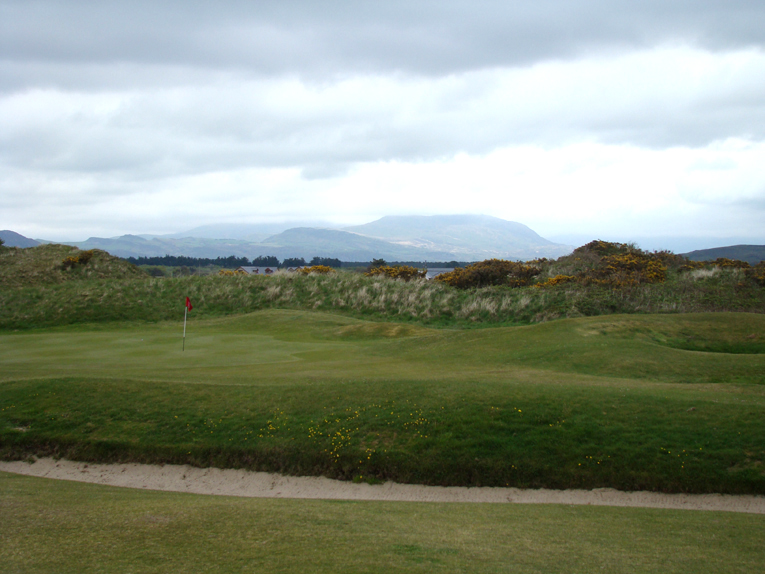
Fisher points out that the great Harry Colt was brought in before the 1926 Ladies’ British Open Amateur Championship. Not much was required but he is credited with this impressive cross bunker 30 yards short of the putting surface.
Like several other well-known courses (Congressional CC, The Cascades Course at the Homestead, and Garden City Golf Club) Harlech finishes unconventionally with a par three. At more than 200 yards in length the hole can be anything from a nine iron to driver depending on the wind. It plays in the opposite direction to the fourteenth, so the two never play the same. This hole is advantaged by finishing beside the clubhouse but lacks the magic of the others on the back nine. Wonder what Finch-Hatton was thinking? Well, Fisher’s Centenary provides the answer with a photograph that shows a handsome nest of bunkers extending well out from the green toward the tee. In its day, Fisher muses that it would have looked like an island green awash in a sea of sand. One hopes that the club will look to restore that innovative bunkering scheme. A course in such a sublime setting deserves a dynamic finish.
Regardless of the report card that the course delivers on one’s game, the club’s distinguished history and the course’s intoxicating setting on a peninsula with the mountains in the background conspire to leave an indelible mark in the player’s mind. Short on size but long on beauty, Wales has many quirky and wonderful settings for golf. Some are of the ‘hit and giggle’ variety which spectacularly compliment the standard bearers of Royal Porthcawl to the south and Royal St. David’s to the north.
Mr. Fisher sums it up nicely when he writes: Harlech is both a great place for a game of golf and a great test of golf (not quite the same thing). In short, it offers the best of both worlds.
The End


